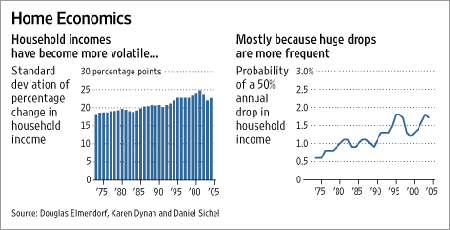From the Wall Street Journal:
Incomes Suffer More Volatility
Amid Heightening Risks, Families Find Ways to Cushion Blows
By GREG IP
June 22, 2007; Page A4
Weighing in on an intensifying debate on income insecurity, three economists — including two from the Federal Reserve — have found that American families today are more likely to experience big drops in their income than three decades ago.
Their analysis, however, finds far less volatility in family income than some recent studies.
The authors of the new study, Douglas Elmendorf of the Brookings Institution and senior Fed economists Karen Dynan and Daniel Sichel, caution against interpreting their findings as evidence that families face more risk of hardship than before. They note that financial innovation has given Americans more ways to maintain their spending when their incomes fall.
The study found that the volatility of household income rose 23% between the early 1970s and early 2000s. While small changes in family income are no more frequent, large changes in income — more than 50% — are.
The probability that a family will experience a decline in annual income of 50% or more, compared with their average income in the previous three years, rose to 1.8% in 1995 from 0.6% in 1973. After 1995, the probability dipped, and has risen back to 1.7%.
…
Yet research into the assumption that income volatility has increased has reached differing conclusions. Yale University political scientist and author Jacob Hacker, in a 2006 book titled “The Great Risk Shift,” documents a fivefold increase in household-income volatility between the early 1970s and early 1990s. Mr. Hacker, who described himself as “thunderstruck” by the result, has written widely and testified to Congress on the subject. He couldn’t be reached for comment.
…
It isn’t clear why the new study found a far smaller increase in income volatility than Mr. Hacker’s despite using the same data. It employs a slightly different yardstick for volatility. Mr. Elmendorf and his colleagues believe that changes in the way the PSID collected and tabulated data in the early 1990s resulted in an artificial increase in the number of people reporting a temporary spell of zero earnings; their calculations exclude households whose head reported zero labor income. In his book, Mr. Hacker says he excludes zero earners, as well.


The authors of the new study, Douglas Elmendorf of the Brookings Institution and senior Fed economists Karen Dynan and Daniel Sichel, caution against interpreting their findings as evidence that families face more risk of hardship than before. They note that financial innovation has given Americans more ways to maintain their spending when their incomes fall.>>>>>>
I think they mean that they tap into their credit cards. Nothing that innovative about that. HELOCs too, but innovative?
Subprime Loan Losses in U.S. Are `Tip of Iceberg,’ Bank of America Says
Losses in the U.S. mortgage market may be the “tip of the iceberg” as borrowers fail to keep up with rising payments on billions worth of adjustable-rate loans in coming months, Bank of America Corp. analysts said.
http://www.bloomberg.com/apps/news?pid=20601103&sid=aFoDV5gMIDUM&refer=news